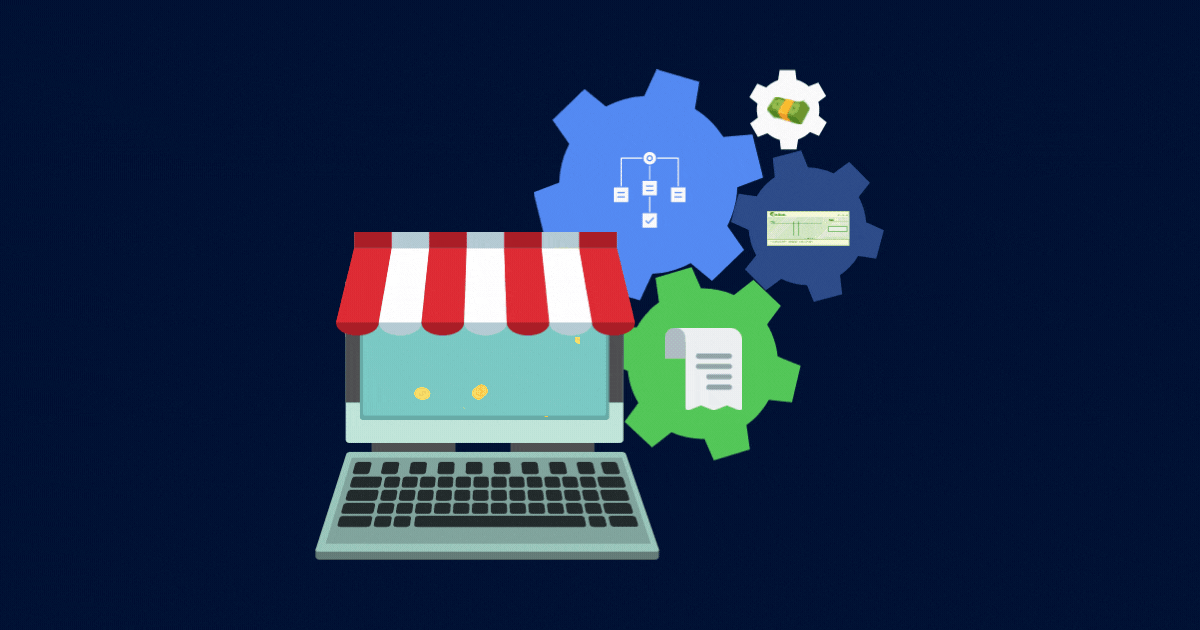
Technology is empowering businesses of all shapes and sizes to scale and grow in ways that simply weren’t possible in the not-so-distant past. Innovations around real-time and cross-border payments and e-commerce, for example, have made it easier for businesses to sell their products and services anywhere in the world. AI and machine-learning powered technologies are making it easier than ever to track, automate, and analyze workflows across all business functions.
At the same time, operational technology like data storage, cybersecurity, customer relationship management, financial automation, and resource planning have made it simple to automate key functions of your business and empower your employees to do more, while spending less.
For growing businesses, technological requirements increase as they become more operationally complex. This is especially true for midsize businesses – any business with between 100 and 999 employees, or between $50 million and $1 billion in annual revenue according to Gartner. The National Center for the Middle Market cites that midsize businesses in the U.S. today account for more than $10 trillion in annual revenues. In Canada, mid-sized enterprises employ about 2.5 million people across the country, which is approximately 20% of the private labour force.
As headcounts rise, revenues increase, and markets expand, midsize businesses are faced with a wide range of technological and logistical challenges that they have not previously navigated. Your company’s “tech stack” is the network of technologies, integrations and partners that make up the technological backbone of your business. If you’re a leader within a midsize enterprise, these are the eight fundamental technologies you should have in your tech stack in 2024 to support efficient growth:
Enterprise Resource Planning (ERP):
What it does:
Enterprise Resource Planning, or ERP, is a type of enterprise software that connects and manages crucial day-to-day business functions like HR, accounting and finance, supply chain management, project management, distribution, risk and compliance, and more.
Why you need it:
ERP technology connects many different functions within your business seamlessly, ensuring that vital information is accessible across functions and teams stay silo-free. A well implemented ERP is the hub that holds together all the spokes of your operational flywheel, creating efficiency across day-to-day workflows.
As mid-sized businesses grow, operational complexities can be a stumbling block without centralized systems that connect each key function of the business. The good news is that there are highly reputable ERPs available, such as SAP, Sage, and Oracle Netsuite, and they offer integrations to easily sync with the role-specific systems your departments already use.
Communication:
What it does:
Business communications tools enable streamlined communications both within your organization and externally with customers, vendors, and partners. They may include email services, conference/video calling, instant messaging and more.
Why you need it:
Ensuring that you have a communications framework that enables you, your team, and your external partners to have clear lines of communication cannot and should not be underestimated. As your operations become more complex, introducing new employees, customers -- maybe even entering new markets -- internal and external communications are absolutely vital to avoid silos and communication gaps. Internal communications can often be neglected, but if your business is growing rapidly or your employee base is expanding across geographies, it is important that your communication technology is scalable to your company’s needs.
Data storage/file management:
What it does:
Data storage and file management technology stores, organizes, and helps you manage all your company’s data and files, including customer data and records, financial information, and legal or human resources documentation. Many email providers, like Microsoft 365 or Gmail will come with cloud-based data storage systems which can be customized to your business needs. But there are also third-party providers that can integrate with your broader technology systems, enabling you to develop an interconnected operational ecosystem.
Why you need it:
Secure data storage is key to protecting confidential and proprietary information that poses risk to your company if exposed. A reliable place to store vital data also ensures that you always have access to the information you need when you need it.
As businesses grow, the volume and complexity of their data grows too. A business with 50 employees and a business with 250 employees will have vastly different data storage needs as they produce a much deeper and more diverse swathe of customer data. Workflows and control over access to data also become more complex as businesses grow, so it is essential that you have a robust system in place to store, secure, and manage access to it across all functions.
Security/risk management:
What it does:
Security and risk management technology protects you, your business, and your customers from threats including fraud, cybersecurity, data breaches, hacks and more. There may be standalone security technology that you can implement, but many other components of your tech stack will have their own security functions and features, like data storage, for example.
Why you need it:
Cybercrime and fraud are significant threats to many businesses. Small-to-medium sized businesses and their finance departments are a very common target for cybercriminals, partially because they are less likely to have the same level of protection and security as a major corporation. A successful cyberattack can be catastrophic for even the biggest companies in the world, but for a mid-size business, it could force them to close their doors.
Having robust security measures in place across your tech stack will ensure that your business stays protected against this growing threat. At the same time, many businesses, especially those that deal with consumers directly, have strict data protection regulations which they must follow, and this technology is often a major component of complying with those rules. Having your customer data compromised can have a massive, lasting impact on your business. A single data breach can eliminate the trust and reputation you’ve built with your customers, regulatory bodies, and peers. As your business generates and manages more and more data, it is fundamental to the future of your company that you have proper security and risk management measures in place.
Accounting:
What it does:
Accounting technology tracks and manages your company’s finances from payables and receivables, to bank accounts, expenses, credit cards, payroll and more. While many companies keep track of these vital functions manually, with the help of an Excel spreadsheet, bookkeeping technology providers can bring much more advanced bookkeeping functions to your business.
Why you need it:
While it’s possible to manage your books in an Excel spreadsheet early on in a company’s lifecycle, having effective accounting software embedded in your tech stack is necessary as you scale operations and employee headcount. For mid-sized businesses that still rely on outdated, manual accounting practices, this can lead to costly human error. Financial complexities that come with scale can be incredibly disruptive without the appropriate financial technology in place to manage workflows efficiently and make sure nothing slips through the cracks.
Cash Management:
What it does:
Cash management is a general term that applies to all of the components of your financial operations related to the money coming in and going out of your business. It includes accounts payable/accounts receivable (AP/AR) automation technology, which allows you to automatically track and manage your entire payables and receivables functions, payroll and expenses, and incoming payments from customers. It also includes the systems through which you can monitor, track, and view your company’s cash flow.
Why you need it:
82% of businesses that fail cite cash flow issues as a contributing factor. As you acquire more customers, you need to scale your teams, vendors, and capabilities to meet that growing demand, which means bringing on additional vendors and partners, and expanding your relationships with existing ones. In short, the bigger your business becomes, the more money you have coming in, and going out, making effective cash management even more challenging, and important.
Automating AP/AR functions, for example, increases both efficiency and accuracy across your finance team’s day-to-day functions. It removes the need for time-consuming manual entry, processing and tracking of incoming and outgoing payments, and automatically connects with your accounting software or ERP to reconcile payments to bills and invoices in those systems. This allows you to always have a complete, current view of your business’ cash flow and trust that your books are accurate, which is crucial for budgeting, forecasting, and planning.
Because you’ll have a complete view of cash going in and out, you’ll also be able to predict when you have surplus to invest in growth opportunities, so you can jump on them with confidence.
Auditing/reporting:
What it does:
Auditing and reporting functionality is often built into other components of your financial tech stack, like cash management tools. This tech tracks and monitors your company’s finances, including payables and receivables, making it easy to access accurate data for taxes and mandatory financial reporting.
Why you need it:
No company wants to be on the receiving end of an audit, but having robust auditing and reporting technology in place ensures that meeting your reporting responsibilities is seamless and automatic, and if you do get audited, the process will be much smoother. This technology will save you significant amounts of time when it comes to year-end tax reporting and is also more accurate than manual tracking.
For companies that rely on external funding, like NGOs, this technology is also a powerful tool to aid grant applications and donor proposals.
Customer Relationship Management (CRM):
What it does:
Customer relationship management (CRM) platforms serve as a centralized hub for teams to effectively manage all customer communications throughout the entire customer lifecycle. These platforms seamlessly integrate with essential marketing tools and may even offer functionalities to host websites and send emails directly from the platform. For sales and marketing teams, incorporating CRMs like Salesforce or HubSpot into their tech stack is indispensable.
Why do you need it:
Having an effective CRM in place ensures that your revenue-driving teams have the tools they need to track, communicate with, and sell to potential customers more effectively, ultimately winning more business. While many growing businesses rely on internal, manual tracking and outreach for these functions, introducing a robust CRM into your sales operations is one of the most powerful ways you can build a more scalable revenue function for your business.
Build a Business That’s Ready for Today, and Tomorrow
Bridging the gap from small business to midsize enterprise is about much more than growing your revenues. To grow sustainably, mid-size businesses need to scale up their operations in virtually every way, from headcount to security to accounting to sales and marketing, often over a very short period of time.
And while mid-size companies have reached a new tier of scale, there are still pitfalls to avoid on the journey to established enterprise. Operational requirements tend to increase rapidly at this stage, and it is crucial for mid-size businesses to adapt their tech stack quickly and effectively, or risk crumbling under the pressures of their new scope, mishandled data, and poor cash management.
For a scaling business, your tech stack is one of your biggest assets, and having the right pieces in place will ensure you keep thriving today while investing strategically in growth for the future.









